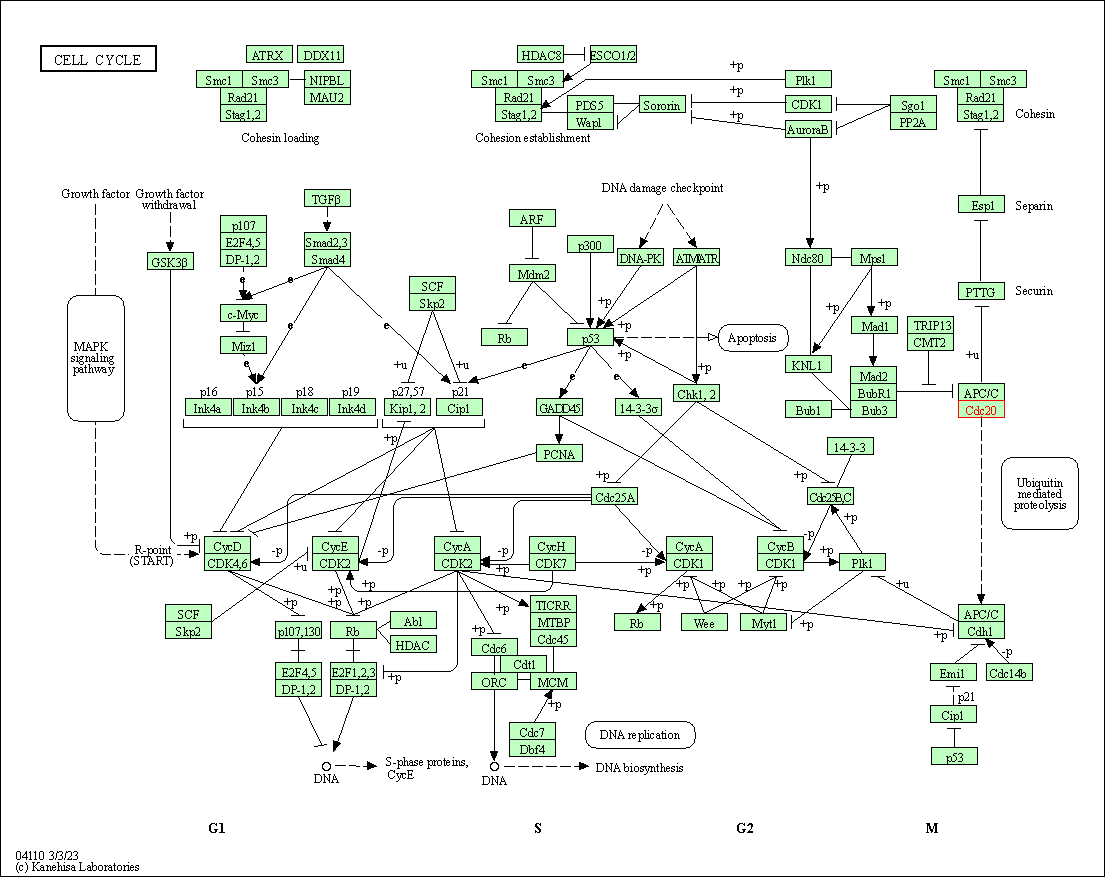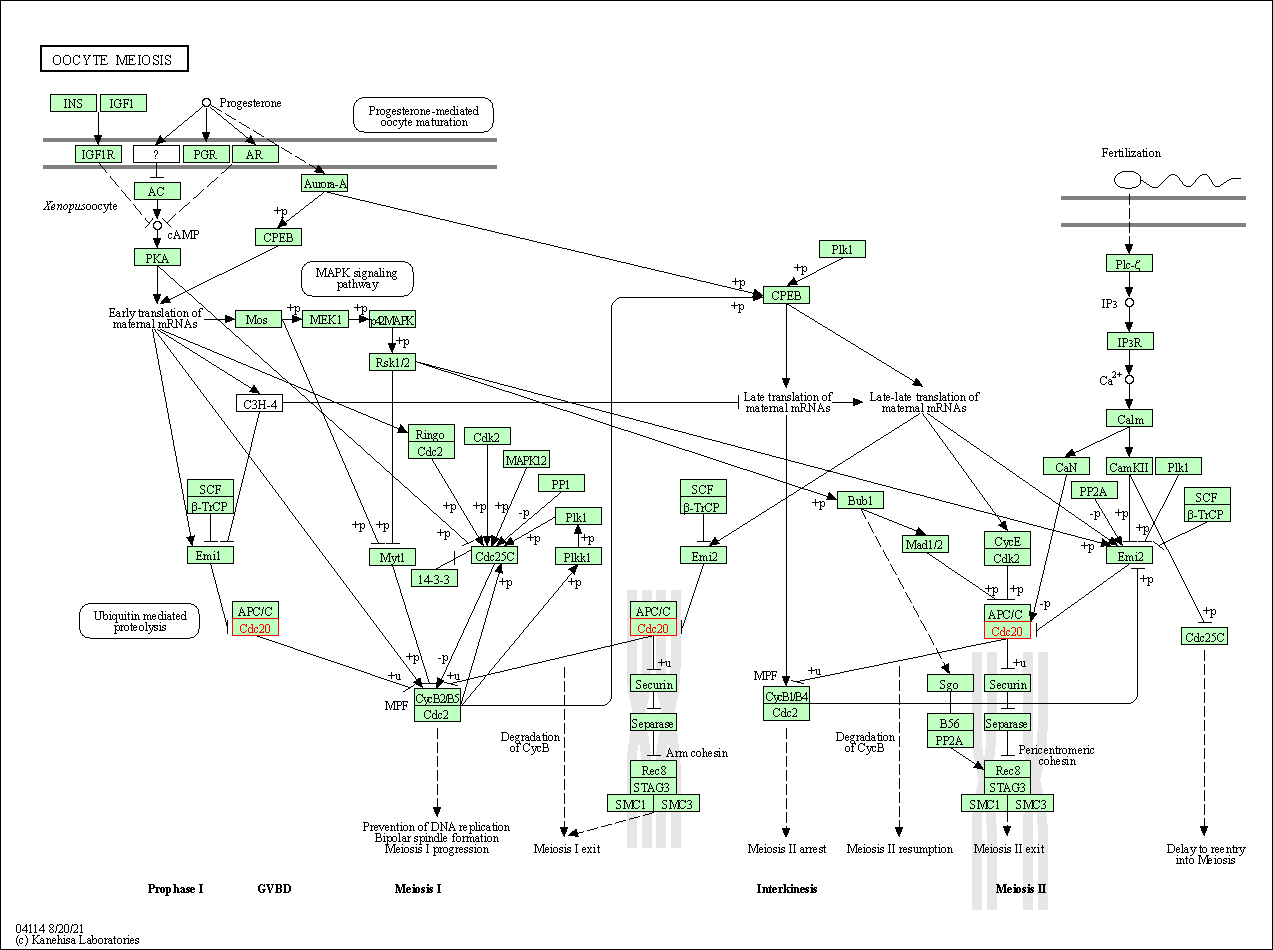Target Information
| Target General Information | Top | |||||
|---|---|---|---|---|---|---|
| Target ID |
T85241
|
|||||
| Target Name |
Cell division cycle protein 20 homolog (CDC20)
|
|||||
| Synonyms |
p55CDC
Click to Show/Hide
|
|||||
| Gene Name |
CDC20
|
|||||
| Target Type |
Preclinical target
|
[1] | ||||
| Disease | [+] 1 Target-related Diseases | + | ||||
| 1 | Solid tumour/cancer [ICD-11: 2A00-2F9Z] | |||||
| Function |
Required for full ubiquitin ligase activity of the anaphase promoting complex/cyclosome (APC/C) and may confer substrate specificity upon the complex. Is regulated by MAD2L1: in metaphase the MAD2L1-CDC20-APC/C ternary complex is inactive and in anaphase the CDC20-APC/C binary complex is active in degrading substrates. The CDC20-APC/C complex positively regulates the formation of synaptic vesicle clustering at active zone to the presynaptic membrane in postmitotic neurons. CDC20-APC/C-induced degradation of NEUROD2 induces presynaptic differentiation.
Click to Show/Hide
|
|||||
| UniProt ID | ||||||
| Sequence |
MAQFAFESDLHSLLQLDAPIPNAPPARWQRKAKEAAGPAPSPMRAANRSHSAGRTPGRTP
GKSSSKVQTTPSKPGGDRYIPHRSAAQMEVASFLLSKENQPENSQTPTKKEHQKAWALNL NGFDVEEAKILRLSGKPQNAPEGYQNRLKVLYSQKATPGSSRKTCRYIPSLPDRILDAPE IRNDYYLNLVDWSSGNVLAVALDNSVYLWSASSGDILQLLQMEQPGEYISSVAWIKEGNY LAVGTSSAEVQLWDVQQQKRLRNMTSHSARVGSLSWNSYILSSGSRSGHIHHHDVRVAEH HVATLSGHSQEVCGLRWAPDGRHLASGGNDNLVNVWPSAPGEGGWVPLQTFTQHQGAVKA VAWCPWQSNVLATGGGTSDRHIRIWNVCSGACLSAVDAHSQVCSILWSPHYKELISGHGF AQNQLVIWKYPTMAKVAELKGHTSRVLSLTMSPDGATVASAAADETLRLWRCFELDPARR REREKASAAKSSLIHQGIR Click to Show/Hide
|
|||||
| 3D Structure | Click to Show 3D Structure of This Target | PDB | ||||
| HIT2.0 ID | T21YK3 | |||||
| Drugs and Modes of Action | Top | |||||
|---|---|---|---|---|---|---|
| Preclinical Drug(s) | [+] 1 Preclinical Drugs | + | ||||
| 1 | Tosyl-l-arginine methyl ester | Drug Info | Preclinical | Solid tumour/cancer | [2] | |
| Mode of Action | [+] 1 Modes of Action | + | ||||
| Inhibitor | [+] 1 Inhibitor drugs | + | ||||
| 1 | Tosyl-l-arginine methyl ester | Drug Info | [1] | |||
| Cell-based Target Expression Variations | Top | |||||
|---|---|---|---|---|---|---|
| Cell-based Target Expression Variations | ||||||
| Drug Binding Sites of Target | Top | |||||
|---|---|---|---|---|---|---|
| Ligand Name: 2-(2-Methyl-5-Nitro-1h-Imidazol-1-Yl)ethyl [(1r)-2,2,2-Trichloro-1-(Pyrimidin-2-Ylamino)ethyl]carbamate | Ligand Info | |||||
| Structure Description | Crystal structure of Cdc20 and apcin complex | PDB:4N14 | ||||
| Method | X-ray diffraction | Resolution | 2.10 Å | Mutation | No | [3] |
| PDB Sequence |
CRYIPSLPDR
174 ILDAPEIRND184 YYLNLVDWSS194 GNVLAVALDN204 SVYLWSASSG214 DILQLLQMEQ 224 PGEYISSVAW234 IKEGNYLAVG244 TSSAEVQLWD254 VQQQKRLRNM264 TSHSARVGSL 274 SWNSYILSSG284 SRSGHIHHHD294 VRVAEHHVAT304 LSGHSQEVCG314 LRWAPDGRHL 324 ASGGNDNLVN334 VWPSAPGEGG344 WVPLQTFTQH354 QGAVKAVAWC364 PWQSNVLATG 374 GGTSDRHIRI384 WNVCSGACLS394 AVDAHSQVCS404 ILWSPHYKEL414 ISGHGFAQNQ 424 LVIWKYPTMA434 KVAELKGHTS444 RVLSLTMSPD454 GATVASAAAD464 ETLRLWRCFE 474 LDP
|
|||||
|
|
||||||
| Click to View More Binding Site Information of This Target with Different Ligands | ||||||
| Different Human System Profiles of Target | Top |
|---|---|
|
Human Similarity Proteins
of target is determined by comparing the sequence similarity of all human proteins with the target based on BLAST. The similarity proteins for a target are defined as the proteins with E-value < 0.005 and outside the protein families of the target.
A target that has fewer human similarity proteins outside its family is commonly regarded to possess a greater capacity to avoid undesired interactions and thus increase the possibility of finding successful drugs
(Brief Bioinform, 21: 649-662, 2020).
Human Pathway Affiliation
of target is determined by the life-essential pathways provided on KEGG database. The target-affiliated pathways were defined based on the following two criteria (a) the pathways of the studied target should be life-essential for both healthy individuals and patients, and (b) the studied target should occupy an upstream position in the pathways and therefore had the ability to regulate biological function.
Targets involved in a fewer pathways have greater likelihood to be successfully developed, while those associated with more human pathways increase the chance of undesirable interferences with other human processes
(Pharmacol Rev, 58: 259-279, 2006).
Biological Network Descriptors
of target is determined based on a human protein-protein interactions (PPI) network consisting of 9,309 proteins and 52,713 PPIs, which were with a high confidence score of ≥ 0.95 collected from STRING database.
The network properties of targets based on protein-protein interactions (PPIs) have been widely adopted for the assessment of target’s druggability. Proteins with high node degree tend to have a high impact on network function through multiple interactions, while proteins with high betweenness centrality are regarded to be central for communication in interaction networks and regulate the flow of signaling information
(Front Pharmacol, 9, 1245, 2018;
Curr Opin Struct Biol. 44:134-142, 2017).
Human Similarity Proteins
Human Pathway Affiliation
Biological Network Descriptors
|
|
| KEGG Pathway | Pathway ID | Affiliated Target | Pathway Map |
|---|---|---|---|
| Cell cycle | hsa04110 | Affiliated Target |

|
| Class: Cellular Processes => Cell growth and death | Pathway Hierarchy | ||
| Oocyte meiosis | hsa04114 | Affiliated Target |

|
| Class: Cellular Processes => Cell growth and death | Pathway Hierarchy | ||
| Ubiquitin mediated proteolysis | hsa04120 | Affiliated Target |

|
| Class: Genetic Information Processing => Folding, sorting and degradation | Pathway Hierarchy | ||
| Degree | 80 | Degree centrality | 8.59E-03 | Betweenness centrality | 2.65E-03 |
|---|---|---|---|---|---|
| Closeness centrality | 2.33E-01 | Radiality | 1.41E+01 | Clustering coefficient | 2.46E-01 |
| Neighborhood connectivity | 3.43E+01 | Topological coefficient | 6.71E-02 | Eccentricity | 12 |
| Download | Click to Download the Full PPI Network of This Target | ||||
| References | Top | |||||
|---|---|---|---|---|---|---|
| REF 1 | Targeting Cdc20 as a novel cancer therapeutic strategy. Pharmacol Ther. 2015 Jul;151:141-51. | |||||
| REF 2 | Emerging therapies targeting the ubiquitin proteasome system in cancer. J Clin Invest. 2014 Jan;124(1):6-12. | |||||
| REF 3 | Synergistic blockade of mitotic exit by two chemical inhibitors of the APC/C. Nature. 2014 Oct 30;514(7524):646-9. | |||||
If You Find Any Error in Data or Bug in Web Service, Please Kindly Report It to Dr. Zhou and Dr. Zhang.

